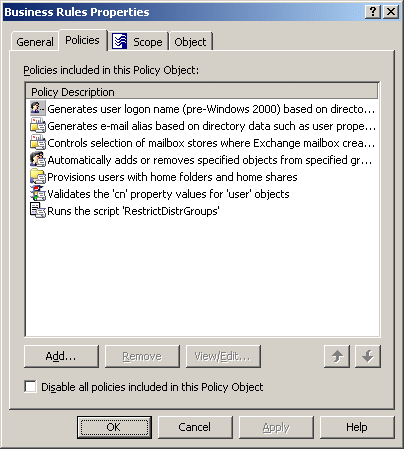Although the New Policy Object Wizard makes it possible to configure only one policy, a Policy Object may include multiple policies. You can add policies, remove policies, and modify policy options in an existing Policy Object by managing its properties: Right-click the Policy Object and then click Properties.
To add, remove, or edit policies in a Policy Object, go to the Policies tab in the Properties dialog. The tab is shown in the following figure.
Figure 39: Policy Objects Management

The Policies tab displays a list of policies defined in the Policy Object. Each list entry includes an icon denoting policy type and policy description. The policies are executed in the order shown in the list. To change the order, use the arrows in the lower-right corner of the tab.
On the Policies tab, you can perform the following management tasks:
-
Add policy: Click Add and follow the instructions in the wizard, which depend on whether you are configuring a Provisioning Policy Object or Deprovisioning Policy Object.
The wizard prompts you to select the type of policy to add and then guides you through the steps to configure the policy. The steps to configure a policy depend on the policy type. For more information on how to configure policies, see Policy configuration tasks.
-
Delete policy: Select policies from the list and click the Remove button. This permanently deletes the policies you have selected.
-
Modify policy: Select a policy from the list and click the View/Edit button. This displays the Properties dialog for the policy you have selected.
The Properties dialog includes several tabs, with each tab containing the same options as the corresponding page of the wizard used to configure the policy. You can manage policy options the same way as you do when initially configuring the policy.
-
Disable all policies: For troubleshooting purposes, you may need to stop enforcement of the policies without actually deleting them. To accomplish this, select Disable all policies included in this Policy Object.
NOTE: The policies that can be added to a given Policy Object depend on the type of the Policy Object. A Provisioning Policy Object can only include provisioning-related policies whereas a Deprovisioning Policy Object can only include deprovisioning-related policies. For more information, see Provisioning Policy Objects and Deprovisioning Policy Objects.
To add a policy to a Policy Object
-
In the console tree, under Configuration > Policies > Administration, locate and select the folder that contains the Policy Object you want to modify.
-
In the details pane, right-click the Policy Object, and then click Properties.
-
On the Policies tab, click Add to start a wizard that helps you configure a policy.
-
On the Welcome page of the wizard, click Next.
-
On the Policy to Configure page, select the type of the policy you want to add.
-
Configure policy settings. For instructions, see Policy configuration tasks.
NOTE: Consider the following when adding policies to Policy Objects:
-
The Policies tab lists the policies that are configured in the Policy Object. You can use the Policies tab to add, modify, or delete policies from the Policy Object.
-
Active Roles processes policies in the order they are listed on the Policies tab. To change the order, select a policy and click  or
or  to move the policy up or down in the list.
to move the policy up or down in the list.
-
Once a Policy Object is applied within Active Roles to determine policy settings in the directory, any changes to the list of policies in the Policy Object causes the policy settings in the directory to change accordingly.
To view or modify a policy in a Policy Object
-
In the Console tree, under Configuration > Policies > Administration, locate and select the folder that contains the Policy Object you want to examine.
-
In the details pane, right-click the Policy Object, and then click Properties.
-
On the Policies tab, select the policy you want to view or modify, and click View/Edit.
-
Use the tabs in the Policy Properties dialog to view or modify policy settings.
The tabs in the Policy Properties dialog provide the same options as the wizard for configuring the policy. For information about the options specific to each type of policy, see Policy configuration tasks
NOTE: Consider the following when modifying policies in a Policy Object:
-
The Policies tab lists the policies that are configured in the Policy Object. You can use the Policies tab to add, modify, or delete policies from the Policy Object.
-
Active Roles processes policies in the order they are listed on the Policies tab. To change the order, select a policy and click  or
or  to move the policy up or down in the list.
to move the policy up or down in the list.
To delete a policy from a Policy Object
-
In the Console tree, under Configuration > Policies > Administration, locate and select the folder that contains the Policy Object you want to modify.
-
In the details pane, right-click the Policy Object, and then click Properties.
-
On the Policies tab, select the policy you want to delete, click Remove, and then click Yes to confirm the deletion.
NOTE: Consider the following when removing policies for a Policy Object:
-
The Policies tab lists the policies that are configured in the Policy Object. You can use the Policies tab to add, modify, or delete policies from the Policy Object.
-
Once a Policy Object is applied within Active Roles to determine policy settings in the directory, any changes to the list of policies in the Policy Object causes the policy settings in the directory to change accordingly.


 or
or  to move the policy up or down in the list.
to move the policy up or down in the list.